| |
Home
Famous and Fascinating Women in History
Frontiersmen and Women
The World's Greatest Composers
Famous Women Spies
Great Authors of the World
Generals and other Noteworthy People
from the Civil War
The Presidents of the United States
The First Ladies of the United States
Homes and Monuments of and to
Famous People
Historical People and Events by Month for Each Day of the Year!
Famous Figures in Black History
The Calvert Family and the Lords Baltimore
Understanding the American Revolution and its People
Everything Beatles!
Everything Maryland! |
| |
|
 
|
 |  |
Benjamin Harrison, His Life, Family
and His Homes
By John T. Marck
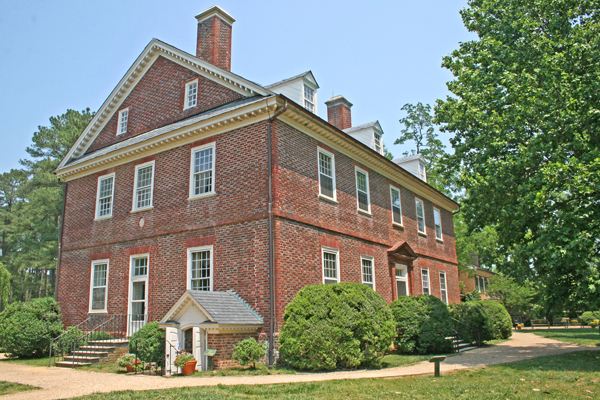
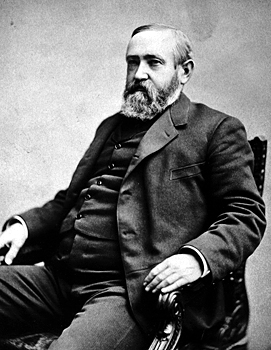
The family
of the future president has a long history in America, as the
Harrison’s were among the First Families of Virginia, with the arrival
of an Englishman at Jamestown in 1630, also named Benjamin Harrison.
The man who would become president, Benjamin was born on August 20,
1833 in North Bend, Hamilton County, Ohio. He was the second of
eight children born to John Scott Harrison and Elizabeth Ramsey Irwin,
and the great-grandson of President William Henry Harrison.
Growing up,
his early schooling was done in a one-room schoolhouse that was
typical of the time. At the age of 12 in 1845, he was provided
with a tutor that assisted him with college preparatory work. In
1847 at age 14, he enrolled in Gary’s Academy, near Cincinnati, which
was a newly built farmer’s college. Benjamin attended this
college for two years, before transferring to Miami University in
Oxford, Ohio, graduating in 1852. While at Miami University,
Benjamin joined a Presbyterian church, of which he remained a
life-long member. After college he started studying law in the
Cincinnati law office of Storer & Gwynne, but before he finished his
studies, he returned to Oxford to marry his fiancée Caroline.
At the age of
20, on October 20, 1853, at Oxford, Ohio, Benjamin Harrison married
Caroline Lavinia Scott, the daughter of Miami University’s president,
Reverend John W. Scott, who also performed the ceremony. The couple
would go on to have two children: Russell Benjamin Harrison
(08/12/1854 – 12/13/1936) and Mary “Mamie” Scott Harrison McKee
(04/03/1858 - 10/28/1930).
After their
wedding, the Harrison’s returned to live on his father’s farm where he
completed his law studies. Upon the death of an aunt, he inherited
$800 and used this money to move to Indianapolis, Indiana in 1854.
Here he was admitted to the bar and began practicing law. He
also worked as a crier for the Federal Court in Indianapolis,
responsible for declaring announcements on the street from the court,
for $2.50 per day.
Early Political Life
Politically,
Benjamin grew up in a Whig household, and was a Whig supporter in his
early life. Upon the formation of the Republican Party in 1856, he
joined and then campaigned on behalf of the Republican presidential
candidate John C. Fremont. Meanwhile Harrison won the election
to become Indianapolis City Attorney, a position that paid $400 per
year.
Two years
later in 1858, Harrison opened his own law firm with another as
Wallace & Harrison. In 1860, Harrison was the Republican
candidate for a position of reporter of the Indiana Supreme Court, and
although this was not a political office, he none-the-less was an
active supporter of the Republican Party platform. During the
election he debated on behalf of the Republican Party against Thomas
Hendricks, the Democratic candidate for governor and future
vice-president of the United States. In 1860, upon his law
partner William Wallace being elected to county clerk, Harrison opened
a new firm with William Fishbank, where he worked until his entry in
the US Army.
The Civil War
In 1862,
President Lincoln issued a call for more men to join the Union Army.
Harrison, while visiting Governor Oliver Morton, found him distressed
over the shortage of new recruits. Harrison asked if he could help
out, and the governor asked him to recruit a regiment, but did not ask
him to directly serve. Harrison did as he was asked, and recruited a
regiment of men in the northern areas of Indiana. Morton offered
him the command of the regiment, but Harrison refused for lack of
military experience, and instead was commissioned as a second
lieutenant. In August 1862, when this regiment left to join the
Union army at Louisville, Kentucky, Harrison was promoted to colonel,
and his regiment became the 70th Indiana Volunteer Infantry
Regiment.

They first saw
action at the Battle of Perryville, and then they performed
reconnaissance duty and guarded railroads in Kentucky and Tennessee.
On January 2, 1864, Harrison was promoted as commander of the 1st
Brigade of the 1st Division of the XXI Army Corps. He would
go on to command at Resaca, Cassville, New Hope Church, Lost Mountain,
Kennesaw Mountain, Marietta, Peachtree Creek and Atlanta. He was later
transferred to the Army of the Cumberland and saw action at the Battle
of Nashville. On March 22, 1865 Harrison was promoted officially
to Brigadier General and marched in the Grand Review in Washington,
D.C. at the end of the war. He left the military on June 8,
1865.
Political Career

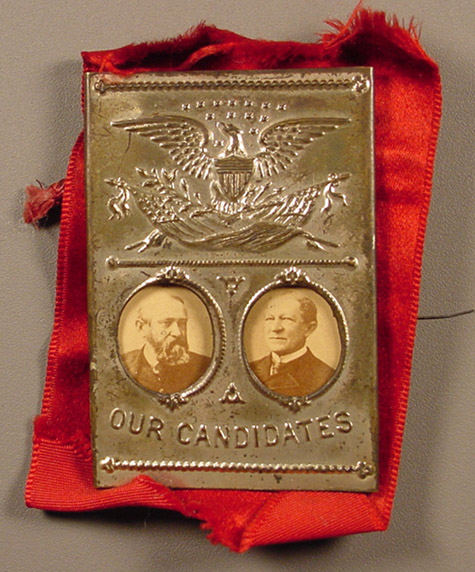
While still
serving in the army, Harrison was reelected as the reporter for the
Indiana Supreme Court and served as such for four more years. In 1872,
he ran in the Republican primary for governor, but did not receive the
support of Governor Morton, who favored his opponent. Harrison
lost this bid, but in 1876, he again ran for the nomination for
governor and was successful. While popular as to his polices, he
lost the election to James D. Williams. In 1880 he was elected to the
United States Senate, and after James Garfield’s victory as president
in 1880, Garfield offered him a cabinet post, which he declined in
order to serve his term as senator. He served as such from March
4, 1881 to March 4, 1887, and was defeated in his bid for reelection.
The Presidency

At the
Republican National Convention, Harrison defeated John Sherman 544 to
108 to win the Republican nomination. In the election of 1888,
Harrison was elected President of the United States by means of a
notoriously fraudulent balloting in New York and Indiana.
Harrison received 90,000 fewer popular votes that the incumbent Glover
Cleveland, but carried the Electoral College 233 to 168. While
Harrison made no political bargains to achieve the election, his
supporters had given numerous pledges on his behalf.
Benjamin
Harrison’s inauguration was held on March 4, 1889, and he served until
March 4, 1893. He became known as the “centennial president,”
because his inauguration celebrated the centenary of the first
inauguration of George Washington in 1789.
Harrison’s presidential
administration is best known for its economic legislation that
includes the McKinley Tariff and the Sherman Antitrust Act, and for
annual spending that reached one billion dollars for the first time.
Democrats attacked what was known as the “Billion Dollar Congress,”
and used this issue to defeat Harrison’s bid for reelection in 1892.
Life After the Presidency
Benjamin
Harrison’s wife died near the end of his presidential term, of
tuberculosis at the White House in October 1892. Following
funeral services at the East Room, she was buried from her own church
in Indianapolis. Upon Caroline’s death, their daughter, Mary
McKee acted a hostess for her father in the last months of his term.
After leaving
office, Harrison returned to Indianapolis and on April 6, 1896 married
his first wife’s widowed niece and former secretary, Mary Scott
Dimmick, in New York City. As she was 25 years younger than
Harrison, his two adult children, Russell, age 41, and Mary, age 38,
did not attend the wedding as they disagreed with it deeming it
inappropriate. Benjamin and his second wife Mary had one child,
Elizabeth (02/21/1897 – 12/26/1955).
Benjamin spent
his last years working at the First Peace Conference at The Hague, and
served as an attorney for the Republic of Venezuela in the boundary
dispute between them and the United Kingdom in 1900. Harrison
also wrote a book titled, “This Country of Ours,” about the
Federal Government and the presidency, published in 1918 after his
death.
In February
1901, Harrison developed a severe cold and despite treatment of steam
vapor inhalation, his condition worsened. He died from influenza and
pneumonia on March 13, 1901 at the age of 67. Benjamin Harrison
is interred in the Crown Hill Cemetery in Indianapolis, Indiana, along
with both of his wives.
President Benjamin Harrison
Home
The President
Benjamin Harrison Home is located at 1230 North Delaware Street in
Indianapolis, Indiana. It is open to the public Mondays –
Saturdays 10:00 a.m. to 3:30 p.m. On Sundays in July, August and
December it is open from 12:30 to 3:30 p.m. Admission is $6.00
for adults, $5.00 for seniors, and $3.00 for students.

As Benjamin
Harrison was a successful attorney he purchased a double lot on the
west side of North Delaware Street at auction in 1867. After the
Civil War, in 1874, he began construction of his 16-room Italianate
style house, a carriage house, a brick drive and landscaping.
The cost for this came to $24,818.67. Except for periods of time
from 1881-1887, when he was in the senate, and 1889-1893 when he was
president, Benjamin and his wife Caroline, and their two children
lived in the Delaware Street home.
After his
presidency, Benjamin returned to Indianapolis a widower. He made
several changes to the house that included an addition of an
English-Regency front porch, electricity, and updated plumbing.
In 1896 he married Mary, and they lived here with their daughter
Elizabeth. It would be in this home that Benjamin died in March
1901.
Following
Harrison’s death in 1901, Mary and Elizabeth lived here until 1913
when they moved to New York. Between 1913 and 1937, the house
was rented to various families and eventually became a rooming house.
In March 1937, the Arthur Jordan Foundation purchased the house and
its furniture. This organization used the house as a dormitory
for the female students in the Jordan Conservatory of Music, that were
formerly housed in a readapted home on the south adjoining lot.
When the foundation purchased the home, they did so with the provision
that the home would also be preserved and considered a memorial to
Benjamin Harrison.
In 1951 the
music school housed here moved to Butler University where it continues
to be known today as Jordan College. Pursuant to an agreement
with Mrs. Harrison, the Arthur Jordan Foundation Trustees opened the
Harrison house to the public. In 1964 the United States
Department of Interior named the home a National Historic Landmark,
and in 1966 the Jordan Foundation created the President Benjamin
Harrison Foundation to maintain and operate the house.
The Benjamin Harrison Artifact and Research Collections
The
collections held here include several sub-collections and archival
categories. The main collection includes the textile, political,
historic photograph, documents, fine arts and furniture collections.
The library contains the archival and book materials recorded in the
library databases. This includes book, letter, newspaper,
microfilm and pamphlet collections. The Harrison family owned
the majority of the books.
The Library at
the President Benjamin Harrison Home houses the largest collection of
papers for President Benjamin Harrison than any other institution
other than the Library of Congress. There is also located here a gift
shop, and the President Benjamin Harrison Foundation offers many
educational programs.
Quick Biographical Facts
BENJAMIN HARRISON
23rd President
Term- March 4, 1889 to March 4, 1893
Republican Party
Birth: North Bend, Ohio, August 20,
1833.
Ancestry: English-Scotch
Marriage: First Marriage: Oxford,
Ohio, October 20, 1853 to Caroline (Carrie) Lavinia Scott, who was
born in Oxford, Ohio, October 1, 1832. Caroline died in Washington,
D.C., October 25, 1892 and is buried in Crown Hill Cemetery,
Indianapolis, Indiana.
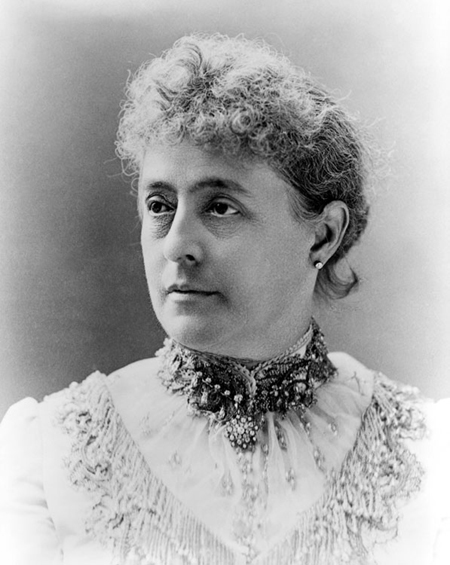
Second Marriage: New York, New York,
April 6, 1896 to Mary Scott Lord Dimmick, who was born in Honesdale,
Pennsylvania, April 30, 1858. Mary died in New York, New York, January
5, 1948, and is buried in Crown Hill Cemetery, Indianapolis, Indiana.

Children: (By first wife) Russell
Benjamin (1854-1936); Mary Scott (1858-1930).
(By second wife) Elizabeth
(1897-1955).

Home: Indianapolis, Indiana
Education: Private tutoring; attended
Farmers College; graduated B.A. (1852) from Miami University.
Religion: Presbyterian
Occupation before Presidency: Lawyer,
notary public, soldier.
Military Service: Appointed col. in
70th Indiana Volunteers (1862); resigned as brevet brig. general in
1865.
Pre-Presidential Offices:
Commissioner for the Court of Claims; City Attorney; Secretary of
Indiana Republican Central Committee; State Supreme Court Reporter;
Member of the U.S. Senate.
Age at Inauguration: 55

Harrison Administration: Vice
President: Levi P. Morton of New York, Inauguration March 4, 1889, The
Capital, Washington, D.C.
Occupation after Presidency: Lawyer
Death: Indianapolis, Indiana, March
13, 1901
Cause of Death: Pneumonia at age 67.
Place of Burial: Crown Hill Cemetery,
Indianapolis, Indiana
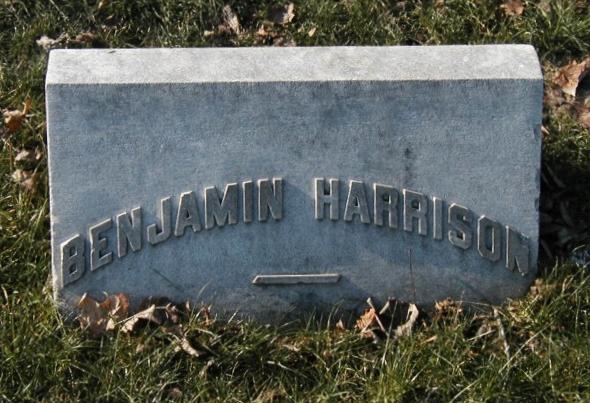
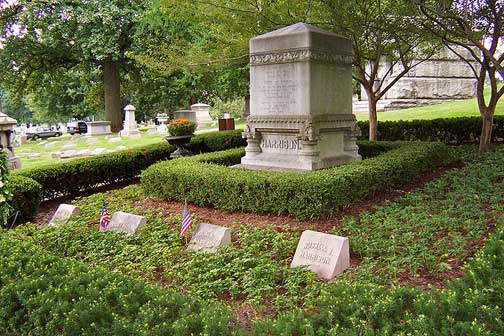
Interesting Facts:
Benjamin
Harrison is the earliest President whose voice is known to be
preserved. There is a 36-second recording that was originally
made on a wax phonograph cylinder in 1889 by Giuseppe Bettini.
Harrison had
electricity installed in the White House in 1891 for the first time by
the Edison Electric Company. However, he and his wife, Caroline,
reportedly would not touch the light switches for fear of
electrocution and often would go to sleep with the lights on.
Harrison has
had many institutions named in his honor that include the Benjamin
Harrison School of Law in Indianapolis, a 1942 United States Liberty
ship named the USS Benjamin Harrison, and a United States Army
post, Fort Benjamin Harrison, established in Indianapolis.
Copyright ©
1992-2022 by
John T. Marck. The author would like to thank for their
information assistance, The President Benjamin Harrison Home,
Indianapolis, Indiana; The National Park Service, Benjamin Harrison
Home; Wikipedia, relative to Benjamin Harrison and his home;
Museumsusa; and The Association of Indiana Museums. Thanks also
to the National Register of Historic Places; National Park Service –
The Presidents. Information as to biographical facts from “The
Presidents of the United States,” by John T. Marck, and
“The First Ladies of the United States,” by John T. Marck,
Copyright © 1993-2008 by John T. Marck.
A
Splendid Time Is Guaranteed For All
| | |
| |
|

